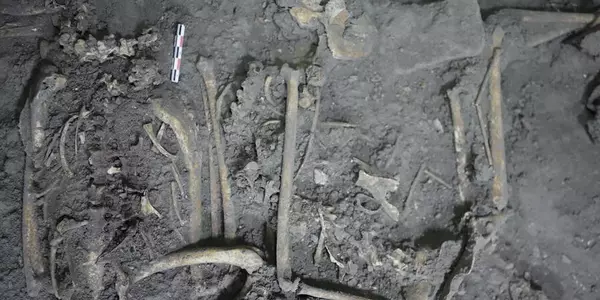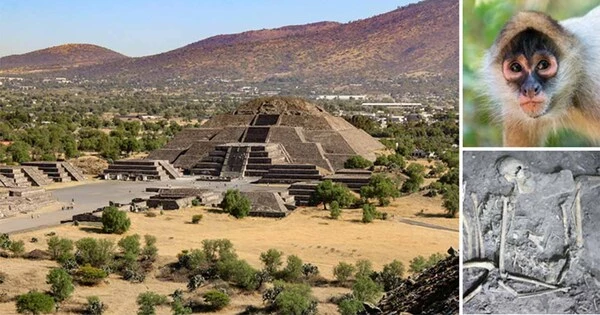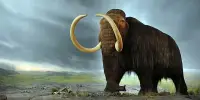It is possible that a team of scientists or archeologists have recently discovered the remains of a 1,700-year-old spider monkey at the ancient Mesoamerican site of Teotihuacán, Mexico. Such a discovery would provide insight into the types of animals that were present in the area during the time that the city was inhabited, and could also shed light on the ways in which the ancient inhabitants of Teotihuacán interacted with and utilized the local wildlife.
The discovery of the complete skeletal remains of a spider monkey, which was once considered an exotic curiosity in pre-Hispanic Mexico, provides researchers with new evidence about the social-political ties between two ancient powerhouses: Teotihuacán and Maya Indigenous rulers.
Nawa Sugiyama, an anthropological archaeologist at UC Riverside, and a team of archaeologists and anthropologists have been excavating at the Plaza of Columns Complex in Teotihuacán, Mexico, since 2015. Other animal remains, as well as thousands of Maya-style mural fragments and over 14,000 ceramic sherds from a grand feast, were also discovered. These pieces date back over 1,700 years.
The spider monkey is the earliest evidence of primate captivity, translocation, and gift diplomacy between Teotihuacán and the Maya. Details of the discovery will be published in the journal PNAS. This finding allows researchers to piece evidence of high diplomacy interactions and debunks previous beliefs that Maya presence in Teotihuacán was restricted to migrant communities, said Sugiyama, who led the research.
The discovery of the spider monkey has allowed us to re-discover previously unknown connections between Teotihuacán and Maya leaders. This dynamic space, depicted in the mural art, was brought to life by the spider monkey. It’s thrilling to re-create this live history.
Nawa Sugiyama
“Teotihuacán drew people from all over the world; it was a place where people came to trade goods, property, and ideas. It was a hub of creativity “Sugiyama is working with other researchers on the project, including Professor Saburo Sugiyama, co-director and professor at Arizona State University, and Courtney A. Hofman, a molecular anthropologist at the University of Oklahoma. “The discovery of the spider monkey has allowed us to re-discover previously unknown connections between Teotihuacán and Maya leaders. This dynamic space, depicted in the mural art, was brought to life by the spider monkey. It’s thrilling to re-create this live history.”
Researchers applied a multimethod archaeometric (zooarchaeology, isotopes, ancient DNA, paleobotany, and radiocarbon dating) approach to detail the life of this female spider monkey. The animal was likely between 5 and 8 years old at the time of death.

Its skeletal remains were found alongside a golden eagle and several rattlesnakes, surrounded by unique artifacts, such as fine greenstone figurines made of jade from the Motagua Valley in Guatemala, copious shell/snail artifacts, and lavish obsidian goods such as blades and projectiles points. This is consistent with evidence of live sacrifice of symbolically potent animals participating in state rituals observed in Moon and Sun Pyramid dedicatory caches, researchers stated in the paper.
The examination of two teeth, the upper and lower canines, revealed that the spider monkey in Teotihuacán consumed maize and chili peppers, among other foods. The bone chemistry, which provides information about the diet and environment, indicates at least two years in captivity. It lived in a humid environment before arriving in Teotihuacán, eating mostly plants and roots.
Sugiyama’s research is primarily supported by grants from the National Science Foundation and the National Endowment for the Humanities. Teotihuacán is a pre-Hispanic city that is a UNESCO World Heritage site and attracts over three million visitors each year.
Sugiyama explained that the discovery, in addition to studying ancient rituals and uncovering pieces of history, allows for the reconstruction of larger narratives, of understanding how these powerful, advanced societies dealt with social and political stressors that very much reflect today’s world.
“This helps us understand diplomacy principles, how urbanism developed… and how it failed,” Sugiyama said. “Teotihuacán was a successful system for over 500 years, and understanding its past resilience, as well as its strengths and weaknesses, is important in today’s society. There are many parallels between then and now. Lessons from previous societies can be observed and modeled; they provide us with cues as we move forward.”














